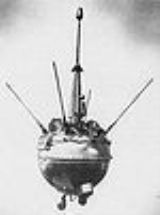
Luna 1959A
Encyclopedia
Luna E-1A No.1 or E-1 No.5, sometimes identified by NASA as Luna 1959A, was a Soviet
spacecraft which was lost in a launch failure in 1959. It was a 387 kilograms (853.2 lb) Luna E-1A spacecraft, the first of two to be launched. It was intended to impact the surface of the Moon
, and in doing so become the first man-made object to reach its surface.
Luna E-1A No.1 was launched at 08:08 UTC on 18 June 1959 atop a Luna
8K72 carrier rocket, flying from Site 1/5
at the Baikonur Cosmodrome
. The rocket's inertial guidance system failed 153 after launch, and as a result the spacecraft failed to achieve orbit.
The spacecraft was intended to conduct experiments during its flight towards the moon. It would also have released gaseous sodium
, in order to create a cloud of the metal which could be observed from Earth, allowing the spacecraft to be tracked. Prior to the release of information about its mission, NASA correctly identified that it had been an attempted Lunar impact mission, however they incorrectly believed that it had been launched on 16 June, two days before its actual launch.
Soviet Union
The Soviet Union , officially the Union of Soviet Socialist Republics , was a constitutionally socialist state that existed in Eurasia between 1922 and 1991....
spacecraft which was lost in a launch failure in 1959. It was a 387 kilograms (853.2 lb) Luna E-1A spacecraft, the first of two to be launched. It was intended to impact the surface of the Moon
Moon
The Moon is Earth's only known natural satellite,There are a number of near-Earth asteroids including 3753 Cruithne that are co-orbital with Earth: their orbits bring them close to Earth for periods of time but then alter in the long term . These are quasi-satellites and not true moons. For more...
, and in doing so become the first man-made object to reach its surface.
Luna E-1A No.1 was launched at 08:08 UTC on 18 June 1959 atop a Luna
Luna (rocket)
The Luna 8K72 vehicles were carrier rockets used by the Soviet Union for nine space probe launch attempts in the Luna programme between 1958-09-23 and 1960-04-16...
8K72 carrier rocket, flying from Site 1/5
Gagarin's Start
Gagarin's Start is a launch site at Baikonur Cosmodrome in Kazakhstan, used for the Soviet space program and now managed by the Russian Federal Space Agency....
at the Baikonur Cosmodrome
Baikonur Cosmodrome
The Baikonur Cosmodrome , also called Tyuratam, is the world's first and largest operational space launch facility. It is located in the desert steppe of Kazakhstan, about east of the Aral Sea, north of the Syr Darya river, near Tyuratam railway station, at 90 meters above sea level...
. The rocket's inertial guidance system failed 153 after launch, and as a result the spacecraft failed to achieve orbit.
The spacecraft was intended to conduct experiments during its flight towards the moon. It would also have released gaseous sodium
Sodium
Sodium is a chemical element with the symbol Na and atomic number 11. It is a soft, silvery-white, highly reactive metal and is a member of the alkali metals; its only stable isotope is 23Na. It is an abundant element that exists in numerous minerals, most commonly as sodium chloride...
, in order to create a cloud of the metal which could be observed from Earth, allowing the spacecraft to be tracked. Prior to the release of information about its mission, NASA correctly identified that it had been an attempted Lunar impact mission, however they incorrectly believed that it had been launched on 16 June, two days before its actual launch.

